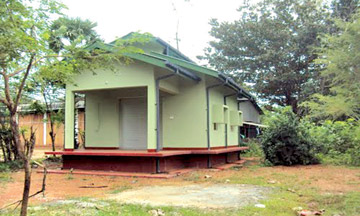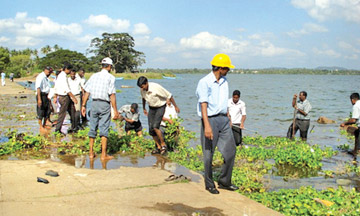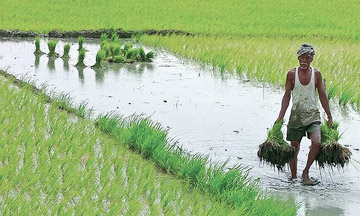|
New dimensions of prosperity and welfare:
Vavuniya bustling with activity
By P. Krishnaswamy
|

Omanthai Railway Station
|
The Vavuniya district which was home to devastated buildings,
disconnected roads and everything lying in ruins three-and-a-half-years
ago with all activities focused on the large number of displaced people
in welfare villages, is now thriving.
The Vavuniya town is bustling with life and activity as a commercial
hub while the rural areas of the district are immersed in agricultural
activities under the many projects implemented by the Government to
increase productivity.
Major development programs that were launched after the defeat and
elimination of LTTE terrorism in May 2009 and were accelerated after the
visit of President Mahinda Rajapaksa consequently have made headway,
transforming the district towards new dimensions of prosperity and
people's welfare.
Paddy cultivation is now undertaken in an extent of 18,544 ha. of
land and the annual production has reached 83,000 tonnes. All abandoned
arable lands have been cleared and used for cultivation. The target for
paddy cultivation by 2016 is 129,200 tonnes. This target is projected to
be achieved through the renovation of more irrigation tanks, increasing
quality seed paddy, using organic fertiliser and more efficient
irrigation technology, according to reports from the Vavuniya
Secretariat.
Focus has been laid on increasing agricultural productivity,
primarily because Vavuniya is an agricultural region with fertile soil
and irrigation facilities. The cultivation of paddy and Other Field
Crops (OFC) have been undertaken in larger areas after the clearing of
abandoned arable lands.
Banks and post-offices have started functioning in the town and its
suburbs.

A seed store |

Cleaning the Vavuniya tank |
 |
| Cultivating
paddy in formerly abandoned land |
OFC are presently cultivated in a land extent of 9,060 hectares and
the annual production is 11,000 tonnes. The targeted achievement by 2016
is 23,200 tonnes. This, again, is projected to be achieved through
improved technology and by using abandoned land.
The fruit crop cultivation at present is 10,700 tonnes and is
targeted to be increased to 24,000 tonnes by 2016. Vegetable cultivation
is presently undertaken in a land area of 30 ha. and is projected to be
increased many-fold by 2016. Other methods for increasing production of
OFC will include improved varieties of seed and planting materials, use
of organic fertiliser and by providing machinery to farmers. A 'chilli
special expansion program' will be implemented to reduce the import of
chillies. Seven acres of land in Navi, one acre in Kanagarayankulam and
57 acres in Kallaru have been earmarked for implementation of the
program.
Seed production
The Government Seed Production Farm has enough stocks of mangoes,
grafted mangoes, oranges, lime, jak, papaw, drumsticks, and vegetable
seedlings. The farm expenditure is Rs.4.3 million, farm income is Rs.
5.67 million and the stock in hand is worth three million rupees.
Machinery distributed among the farmers include 113 sprinklers, 1,024
water pumps, 100 four-wheel-tractors, 74 two-wheel-tractors, 410
sprayers and 260 crates. A total of Rs.2.497 million was allocated this
year for various agricultural-related projects of the provincial special
development fund such as community-based fundamental seed production
village project, ground nut crop coordination project, ground nut
production project, chilli expansion project, black gram production
project, Api Wawamu Rata Nagamu project and red onion cultivation
project. A total of 2,608 persons will benefit under these projects.
According to reports from the Director of Development for the
district, all disconnected, damaged and dilapidated highways and roads,
including rural roads, have been renovated and rehabilitated. Ninety
percent of de-mining has been completed and all displaced families have
been resettled.
Over 4,985 families comprising 17,993 persons have been resettled in
the Vavuniya Divisional Secretariat area; 1,377 families comprising
4,516 persons have been resettled in the Vavuniya North Divisional
Secretariat area, 3,926 families comprising 12,638 persons have been
resettled in the Vavuniya South Divisional Secretariat area while
another 1,641 families comprising 6,021 persons have been resettled in
the Vengadacheddikulam Divisional Secretariat area.
RDD/C&D Class roads extending 112.32 km have been rehabilitated at an
expenditure of Rs.96.464 million under the Uthuru Vasanthaya program for
2009, under 16 projects. Twelve projects under the Land Commissioner's
Roads Projects and 47 projects under ACLG/Rural Roads Projects were
completed at a total expenditure of Rs.180.391 million and the length of
road covered is 150.92 km.
For 2011, the number of projects completed under the UC is five and
the total expenditure is Rs. 40.12 million. For 2012, the number of
projects completed under the UC is three and the expenditure is Rs.46.24
million.
Under the Vavuniya South Tamil Pradeshiya Sabha (PS) five projects
were completed in 2011 at an expenditure of Rs. 32.49 million. This year
nine projects were completed under the PS at an expenditure of Rs. 46
million.
Three projects under the Vavuniya South Sinhala PS were completed at
an expenditure of Rs.51.50 million last year and this year, five
projects were completed by the PS at an expenditure of Rs.64 million.
Under the Vavuniya North PS, one project was completed at an expenditure
of Rs.37 million for 2011 and five projects were completed for 2012 at
an expenditure of Rs.269.24 million.
Under the program of increasing agricultural productivity in the
district, three major irrigation tanks and 48 minor tanks have also been
rehabilitated under the Uthuru Vasanthaya program for 2009 at an
expenditure of Rs.71.831 million. A total of 306 projects have been
completed at an expenditure of Rs.253.75 million during the period 2006
- 2011 under the Gama Neguma programs.
Divi Neguma
Under the Divi Neguma 2011 program, 25,200 seed packets and plants
were supplied to farmers at an expenditure of Rs.0.19 million. Over
20,450 coconut plants were supplied at an expenditure of Rs.1.12
million. Over 3,000 cashew plants were distributed at an expenditure of
Rs.0.35 million. These were under fund allocations from the Ministry of
Economic Development.
Four projects at an expenditure of Rs.0.28 million were implemented
by the Samurdhi Authority.
Under the Divi Neguma 2012 program, 12,450 packets of seeds/plants,
vegetable and fruit plants and poultry were supplied at a cost of four
million rupees by the Ministry of Economic Development.
Under the Accelerated Crop Production program, Rs.3.16 million was
allocated for seed production programs. A sum of Rs. 1.5 million was
allocated for production of seed red onion, sesame seeds, ground nut,
chilli and black gram.
Under the Samurdhi Development Program, aimed at improving the
livelihood of the poor to make them join the national development
process, assistance was extended to 11,248 families and the total
expenditure is Rs.202.02 million. The number of livelihood development
programs implemented is 13,158 and the total investment is Rs.57.29
million. The number of Samurdhi Bank societies is seven and the total
Samurdhi Bank investment is Rs.136.75 million. The total number of
persons to whom bank loans were extended is 12,127 and the amount is
Rs.185.69 million. A total of 119 infrastructure development projects
were implemented at a cost of Rs.55.48 million.
The sluice at the Irrataperiyakulam Scheme was constructed and
facilities provided for irrigation to 203.21 Ha land. The irrigated area
under the Pavatkulam Tank Scheme is 1,673.44 Ha.
The Rajendramkulam Tank, Maruthamadhu Tank and the Eropothana Tank
were renovated and an irrigation canal was constructed from the
Pavatkulam Tank.
Thirteen medium tanks were renovated at a total cost of Rs.440
million. Future plans for 2013-2016 under provincial irrigation include
rehabilitation of the balance four tanks at a cost of Rs.100 million,
introducing OFC for Yala under eight schemes at a cost of Rs.100 million
and de-silting of tank beds (to impound 100 acres of dead storage) at a
cost of Rs.120 million.
Four rice mills were established at a cost of Rs. 63.6 million and
were installed with machinery. |


